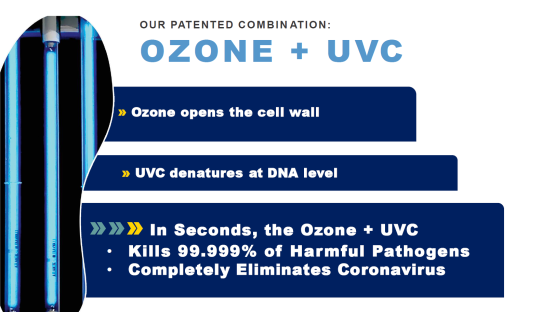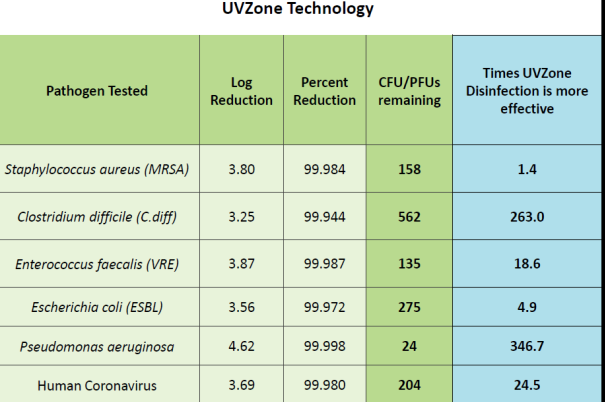
Coronavirus
Technology Solutions
October 1, 2020
COVID
Disinfection Technologies Webinar
Showcases to Unique Technologies
Novel Approach Uses Food Dyes to Disinfect Air
Foot Sanitizers for Food and Other Facilities
Can Effectively Reduce COVID Transmission
New Bedford Has Spent Over
$400,000 to Purchase Air Purifiers for Its
Classrooms
______________________________________________________________________________
COVID
Disinfection Technologies Webinar
Showcases to Unique Technologies
Today we recorded a discussion with
presentations of two technologies and then
insights on
applications including schools, film
studios, restaurants, transportation and food
processing plants.
Photodynamic Airborne Cleaner


Ozone and UVC Shoe Disinfection Technology


Review of Applications Including Schools and
Food Processing Plants


This webinar can be viewed at:
https://youtu.be/_Lu4Om6I15c
Novel Approach Uses Food Dyes to Disinfect Air
Young Kim of Purdue University described the
Photodynamic Airborne Cleaner (PAC) which
inactivates the virus by creating singlet
oxygen.
“Our
biomedical engineering lab has developed a way
to potentially neutralize viruses lingering in
the air using aerosols of FDA-approved food
coloring dyes. Aerosols are tiny bits of solid
or liquid matter suspended in air.
“Our idea was inspired by photodynamic therapy,
which is a medical treatment, including for
certain types of cancer. Photodynamic therapy
uses a photosensitizer, a chemical that reacts
with oxygen in the presence of light, to produce
oxygen free radicals. These radicals are highly
reactive, meaning they trigger other chemical
reactions, including ones that kill harmful
pathogens.
“Instead of using expensive medical
photosensitizers, we have identified several
FDA-approved food coloring dyes that can be used
to generate free radicals in visible light. We
use ultrasound to generate small aerosols
containing the food coloring so that the dyes
can float and linger in the air. The aerosols
are barely visible, and their small size and
short lifespan in light means they don’t stain
surfaces.”

Young showed other distribution methods
including a drone which could traverse a
convention hall or other large space. In the
later discussion he agreed with the observation
by Bob McIlvaine that if this was injected in
the outlet of a fan filter unit above a checkout
counter it would provide
deactivation in an area of high traffic.
Here is how the technology works.

The PAC has advantages in terms of safety since
it uses food dyes.

Young described considerable effort which has
been undertaken to create droplets in the 5
micron range. These are small enough to be
widely distributed but large enough to avoid
penetration into the lungs.
In the subsequent questioning concern was raised
that the 5 micron droplets would start to
evaporate and form smaller aerosols. On the
other hand if those people in the range of the
droplets are wearing masks then there should not
be a problem. One can visualize a modus operandi
where people wear masks when they are not social
distancing but when at their desks can remove
the masks. They would then put them back on if
there would be a spraying event in the area.
The PAC offers a new option which deserves very
thorough
review.
To view the power points click on
http://home.mcilvainecompany.com/images/Mcilvaine_10-1-2020_Purdue_Univ_YKim.pdf
this was the first presentation in the webinar.
To view the recording click here:
https://youtu.be/_Lu4Om6I15c
Foot Sanitizers for Food and Other Facilities
Can Effectively Reduce COVID Transmission
Robyn Collins of PathO3Gen updated us
on the value of foot sanitizers. The company has
continued to make progress since the last
webinar with them. Food companies have been hard
hit by COVID. In addition they face other risks
from pathogens including food recalls. Here some
of the impacts in the U.S.

Food companies have even more to be gained from
the use of foot sanitizers than does the average
industrial plant owner. Many owners of buildings
whether industrial or commercial will benefit
from the foot sanitizer because it will prevent
the viruses on shoes from entering the building
and spreading not just to the floors but to
walls and furniture. Studies attest to the
ability of these viruses to become airborne and
reach elevated areas within a hospital but in
other facilities as well.

Stepping on the sanitizer for as little as 8
seconds provides the necessary deactivation. The
effectiveness is due to combining ozone and UVC.

The effectiveness of the combination is much
greater than just UV

There are many applications where the foot
sanitizer will be cost effective. Since the cost
is only $13/day or less for one unit it is
economical for even small applications. Another
viewer today asked about residences. She lives
in a building with 100 residences. So the cost
per day is less than $0.13 per family. The fact
that shoes showed high levels of fecal matter
makes it particularly advantageous for apartment
and condominium dwellers.
There was also discussion as to whether the high
value of the sanitizer is not proven by the low
level of COVID spread in Japan. The custom in
that country is to remove shoes prior to entry
to a residence.
Maybe this is a good way to sell the technology.
You can ask subway riders in NY whether they
would rather take off their shoes while
riding or step on the foot sanitizer.
To view the PathO3Gen power points
click here:
http://home.mcilvainecompany.com/images/PathoGen3_Presentation_093020.pdf
This is the second presentation in the
recording. To view it click here:
https://youtu.be/_Lu4Om6I15c
New Bedford Has
Spent Over $400,000 to Purchase Air Purifiers
for Its Classrooms
UMass Dartmouth biology professor Erin Bromage
is recommending schools take some expensive but
essential measures to improve ventilation and
air quality in the classroom with colder weather
approaching.
He is advising that districts purchase HEPA
filter units for every classroom when the
weather gets cold and schools can no longer
properly ventilate with fans in the windows. The
filters are standalone units and range in price
from $200 to $300 and $500 to $600 each.
The filters strip particles of the virus out of
the air and they also provide protection against
allergies and the flu by purifying the air, he
said. The air quality becomes “better than (in)
a hospital room” when a HEPA filter is used.
Bromage acknowledges the filters will be an
expensive purchase for school districts.
“It is an investment. If education is an
essential service, then we should put money
there,” he said in an interview with The
Standard-Times. “It’s not good to say education
is an essential service and not put money
there.′
Bromage said districts should expect that
schools with approximately 250 students will
have one student per month who tests positive
for the virus in communities with low rates of
new infections. The student will have contracted
the virus in the community.
He has earned a national reputation because of
his blog, “ERIN BROMAGE: COVID-19 MUSINGS,”
where he takes scientists’ data and raw
materials about the coronavirus and translates
them into layman’s language the public can
understand. A blog post in May received a
mention in The New York Times’ online news
summary, “The Morning,” and attracted over 15
million hits.
He is now working with Rhode Island Gov. Gina
Raimondo to advise school districts about
keeping students and staff safe.
Andrew O’Leary, the assistant superintendent of
finance and operations for New Bedford Public
Schools, said the system has purchased air
purification systems which have already started
to arrive. The estimated final cost is over
$400,000 and is covered by COVID funding
approved in July.
“It appears that the air purification units when
deployed are the solution,” O’Leary said, after
NBPS commissioned a company to study the air
flows in all its schools. “We will have schools
that are safe, comfortable and healthy.”
The superintendent and his leadership team, with
input from educators and families, have worked
to plan for a successful school year in spite of
the challenges that the pandemic has created.
Their thoughtful plan to ensure the health of
our students and staff, including through added
air exchange and purification in one of the
state’s oldest stocks of school buildings, is
well underway,” Mayor Jon Mitchell said in a
statement.
Bromage said poor ventilation increases the
risks of the virus in the classrooms and he
advises using simple exhaust fans and box fans
to improve air quality. It is a matter of
exchanging indoor air for outdoor air several
times a day.
“As many times per hour that you can exchange
indoor air for outdoor air, the better you are,”
he said. “It will result in a much safer
classroom.”
The goal is to stop “super spreading events” and
make “indoor space more like outdoor space,” he
said.
He recommends “at least six air changes per
hour” for the safety of students and staff and
said, “the minimum (number of air exchanges) is
four.” A box fan can remove about 2,000 cubic
feet of air per minute.
The weather on SouthCoast is currently “perfect”
for ventilating classrooms with fans, he said.
He cited the example of Friends Academy in
Dartmouth, which is holding classrooms outside,
to expose students to healthier air.
The issue of ventilation will become more
problematic as winter approaches and it becomes
too cold to open classroom windows, he said.
HEPA filters should be used in the winter and
districts should be planning for them now.
“Schools that can do that are ready to go,”
Bromage said.
He said the solution to keeping everyone in the
schools safe requires layers of protection,
including social distancing, the wearing of
masks, exchanging indoor air for outdoor air
with fans and HEPA filters.
Assistant Superintendent O’Leary said the
ventilation firm they hired made recommendations
to improve air quality in all the schools. New
Bedford public school system’s buildings are one
of the oldest statewide with different types of
deficiencies apparent in structures built
between 1900 and 1940 and in 1950 to 1970. NBPS
also has three modern middle schools and several
modern elementary schools.
The School Department has developed a range of
recommendations for the schools from opening
windows, using box fans and “building flushes”
to maximize outdoor air, he said.
